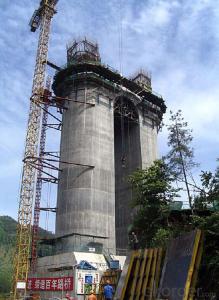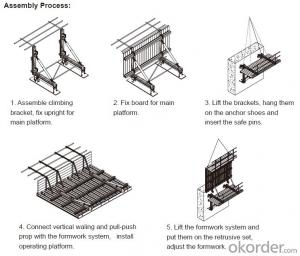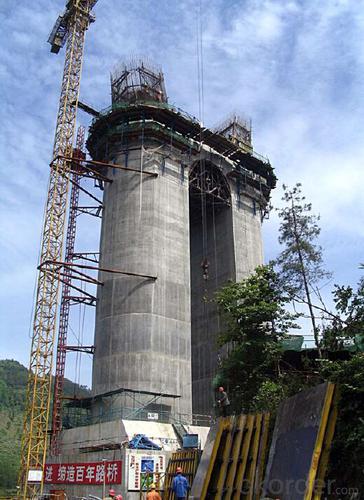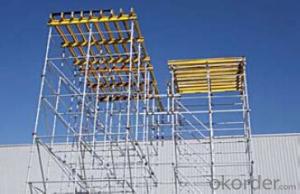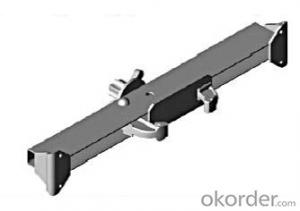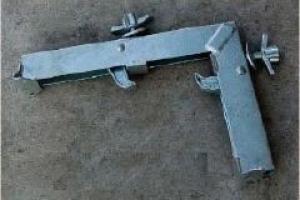Auto Climbing Bracket ACB-100 & ACB-50 for formwork and scaffolding systems
- Loading Port:
- Tianjin
- Payment Terms:
- TT OR LC
- Min Order Qty:
- 50 m²
- Supply Capability:
- 1000 m²/month
OKorder Service Pledge
OKorder Financial Service
You Might Also Like
Auto-climbing Bracket ACB100 & ACB50
The power of the auto-climbing formwork is the hydraulic system, which includes the oil cylinder
and two commutators. The commutators can control the climbing of climbing rail and the bracket.
The steel rail and the bracket can inter-climbing, so the whole system will climb up steadily.
Cranes are not needed during the construction. It’s easy to operate, highly efficient and safe. It’s
the best choice for the construction of high buildings and bridges.
There are mainly two types of standard auto-climbing brackets, ACB-50 and ACB-100, the figure
means the push power of cylinder with unit of KN.
Characteristics:
◆ Perfect load bearing anchor system
Anchor system is the most important supporting part. The system is made of five parts shown
below. Thereinto, tensile bolt, V-climbing cone and washer can be taken out for reusing after the
concrete pouring finished.There are two kinds of anchor systems,A & B. A is matched with single
anchor shoe and B is matched with double anchor shoe.
◆ Crane-independent
Crane-independent forming, striking and climbing speeds up the work procedures on the
construction site and also makes them independent of each other. This means the planned
sequences can be maintained along with guaranteeing high productivity levels. The crane can
therefore be used for other tasks.
Hydraulic system is mainly made of two commutators,
oil cylinder and power distribution system.The
commutators can control the climbing of climbing rail
and bracket.
◆ High bearing capacity and safe
The stable working platforms are able to carry large loads, e.g. the storage of reinforcing steel
for the next climbing section. Generously-sized working platforms, the well thought-out design for
handling very high wind loads and the patented control function of the climbing mechanism are
some of the special details contained within the comprehensive safety concept.
◆ Platforms adjusted to suit the angle of inclination
The horizontal working areas thus created provide safe and comfortable conditions for
reinforcement work, shuttering and striking, concreting and finishing.
◆ The ACB formwork system can climb not only vertically but also slantways, the largest angle is
18 degrees.
◆ The system can climb up wholly or separately. The climbing process is steady, synchronous
and safe.
◆ The bracket will not fall to the ground until the construction is finished, the field will be saved
and the impacting breakage will be reduced (especially the panel).
◆ The system will furnish omnidirectional platform, the construction organizations don’t need to
set up additional operation platform.
◆ The error of structure construction is small and easy to correct.
◆ The climbing speed is fast, the construction course will be quickened.
◆ The formwork can climb itself and cleaning work can be done in the same situs , the used times
of tower crane will be greatly reduced.
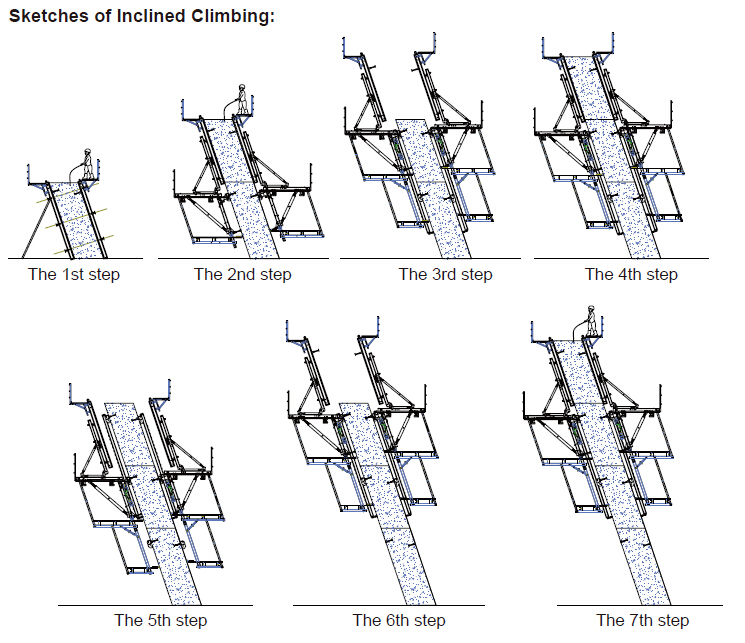
- Q: What are the common safety precautions when working with steel formwork?
- Some common safety precautions when working with steel formwork include wearing appropriate personal protective equipment (PPE) such as hard hats, safety glasses, gloves, and steel-toe boots. It is also important to ensure that the formwork is properly secured and braced to prevent collapse or movement. Regular inspections should be conducted to identify any defects or weaknesses in the formwork. Additionally, workers should receive proper training on how to safely assemble, disassemble, and handle the steel formwork to avoid any potential injuries.
- Q: What are the common design considerations for steel formwork in marine environments?
- When designing steel formwork for marine environments, there are several common considerations that need to be taken into account. These considerations are necessary to ensure the durability and longevity of the formwork in the harsh marine environment. Some of the common design considerations for steel formwork in marine environments include: 1. Material Selection: The selection of appropriate materials is crucial for withstanding the corrosive effects of saltwater. Stainless steel or other corrosion-resistant alloys should be used to prevent rusting and deterioration. 2. Coatings and Surface Treatments: Applying protective coatings or surface treatments can further enhance the corrosion resistance of the steel formwork. These coatings may include zinc-rich primers, epoxy coatings, or galvanization to provide an additional layer of protection. 3. Reinforcement and Strengthening: Marine environments can subject the formwork to significant forces such as waves, currents, and impact from floating debris. Reinforcement and strengthening measures, such as additional bracing or thicker steel sections, may be necessary to ensure structural integrity. 4. Drainage and Ventilation: Proper drainage and ventilation are crucial to prevent the accumulation of water, which can accelerate corrosion. Designing the formwork with appropriate drainage channels or weep holes can help remove any trapped moisture. 5. Connection Details: Special attention should be given to the connection details in marine environments. Corrosion-resistant fasteners, such as stainless steel bolts or galvanized screws, should be used to prevent premature failure due to corrosion. 6. Maintenance and Inspection: Regular maintenance and inspection are essential to identify any signs of corrosion or damage. Scheduled cleaning, removal of marine growth, and applying protective coatings as needed will help extend the life of the formwork. 7. Environmental Considerations: The marine environment is often subject to extreme conditions such as high winds, tidal forces, and exposure to UV radiation. The design should consider these factors to ensure the formwork can withstand these environmental loads. Overall, the design of steel formwork for marine environments necessitates careful consideration of material selection, coatings, reinforcement, drainage, connection details, maintenance, and environmental factors. By incorporating these considerations into the design process, engineers can ensure that the formwork will withstand the harsh marine conditions and provide a reliable and durable solution.
- Q: How does steel formwork handle different concrete finishes?
- Due to its durability and versatility, steel formwork is a popular option in the construction industry. It has been proven to be highly effective in handling various concrete finishes. A key advantage of steel formwork is its smooth and rigid surface, which enables the easy attainment of a wide range of concrete finishes. Whether it is a smooth, textured, or exposed aggregate finish, steel formwork can accommodate them all. In the case of smooth finishes, the level and even surface of the steel formwork allow for seamless pouring and finishing of the concrete. The smooth surface also contributes to achieving a high-quality finish with minimal imperfections like air pockets or surface blemishes. For textured finishes, steel formwork can easily adapt to different textures. This can be achieved by utilizing specialized liners or inserts that are affixed to the steel formwork. These liners or inserts create the desired texture on the concrete surface as it sets, resulting in a textured finish. Furthermore, steel formwork excels in handling exposed aggregate finishes. This type of finish involves revealing the aggregates, such as stones or gravel, in the concrete mix to create a decorative and textured surface. The smooth surface of the steel formwork allows for even distribution and exposure of the aggregates once the concrete is finished and cured. Additionally, the reusability of steel formwork is well-known. It can be used multiple times without compromising its structural integrity or surface quality. This reusability factor makes steel formwork a cost-effective choice for managing various concrete finishes, as it can be utilized for different projects. In conclusion, steel formwork is a highly versatile option for construction, capable of effectively handling different concrete finishes. Its smooth and rigid surface enables the achievement of smooth, textured, and exposed aggregate finishes. Moreover, the reusability of steel formwork makes it an economical choice for contractors and construction projects.
- Q: How does steel formwork handle concrete flowability and workability?
- Due to its durable and rigid nature, steel formwork is highly effective in managing the flowability and workability of concrete. When concrete is poured into the steel formwork, it easily takes on the desired shape, resulting in a smooth and even finish. The support and stability provided by the steel formwork prevent any deformation or movement during the pouring and curing process. The design of the steel formwork ensures that it can withstand the pressure exerted by the concrete, making it capable of handling variations in flowability. With its tight joints and smooth surfaces, the formwork allows for better control of the concrete's flow, preventing any leakage or seepage. This enables precise and uniform placement of the concrete, ensuring consistent quality throughout the structure. Furthermore, steel formwork is highly adaptable, allowing for easy adjustments and modifications to accommodate changes in concrete flowability and workability. It can be quickly assembled, disassembled, and repositioned as needed, providing flexibility in construction projects. In addition, steel formwork offers a high level of reusability. Its durability and resistance to wear and tear make it suitable for multiple placements of concrete, reducing construction costs and environmental impact. In conclusion, steel formwork effectively manages concrete flowability and workability by providing a stable and rigid structure that supports the concrete during placement and curing. Its adaptability, durability, and reusability make it the preferred choice in construction projects requiring precise and consistent concrete finishing.
- Q: Can steel formwork be used in seismic-prone areas?
- Yes, steel formwork can be used in seismic-prone areas. Steel formwork is known for its high strength and durability, making it suitable for use in areas with high seismic activity. It provides excellent resistance against the lateral forces generated during an earthquake, ensuring the structural integrity of the formwork system. Additionally, steel formwork offers flexibility in design and can be easily adjusted or modified to accommodate the specific requirements of seismic-prone areas. It is important, however, to ensure proper engineering and design considerations are applied when using steel formwork in these areas to ensure it meets the necessary safety standards and regulations.
- Q: What are the environmental considerations of using steel formwork?
- Some of the environmental considerations of using steel formwork include its high carbon footprint due to the energy-intensive manufacturing process, the potential for metal waste generation during construction, and the need for recycling or disposal at the end of its lifespan. However, steel formwork is durable and reusable, reducing the overall material consumption and waste generation compared to other formwork materials. Additionally, steel formwork can contribute to the sustainable use of resources if properly managed and recycled after use.
- Q: What are the common finishes available for steel formwork?
- Different finishes are available for steel formwork, depending on the project's requirements. Some commonly used finishes include: 1. Smooth finish: This is the basic and widely used finish for steel formwork. It provides a smooth surface suitable for most applications. 2. Textured finish: By using special form liners or applying a textured coating to the steel formwork, a textured finish can be achieved. This finish adds visual interest and provides a non-slip surface. 3. Galvanized finish: The steel formwork can be protected by applying a zinc coating through galvanizing. This finish offers excellent corrosion resistance, making it suitable for projects in harsh environments. 4. Powder-coated finish: Powder coating involves applying a dry powder to the steel formwork and curing it with heat to create a protective layer. This finish is durable, resistant to chipping and scratching, and offers a wide range of color options. 5. Painted finish: Steel formwork can also be painted to achieve the desired aesthetic appearance. Paint provides corrosion protection and can be customized to match the project's design requirements. When selecting the appropriate finish for steel formwork, it is important to consider the project's specific requirements, including expected lifespan, environmental conditions, and aesthetic preferences. Consulting with a structural engineer or construction professional is recommended to determine the most suitable finish for a particular project.
- Q: How does steel formwork differ from other types of formwork?
- Steel formwork differs from other types of formwork in several ways. Firstly, steel formwork is known for its durability and longevity. Unlike wooden or plastic formwork, which may require frequent replacements due to wear and tear, steel formwork can withstand heavy usage and can be reused multiple times. This makes it a cost-effective option in the long run, as it eliminates the need for constant formwork replacements. Additionally, steel formwork offers a higher level of precision and accuracy in construction. The rigid structure of steel formwork ensures that the concrete is poured and cured in the desired shape and dimensions. This is particularly important in projects that require high-quality finishes or complex architectural designs. Moreover, steel formwork provides excellent structural support. It can withstand the pressure exerted by wet concrete without deforming or collapsing, ensuring the stability and safety of the construction process. This is especially crucial in large-scale projects or in situations where high concrete volumes are involved. Furthermore, steel formwork is versatile and can be easily customized to meet specific project requirements. It can be easily assembled and disassembled, allowing for quick and efficient construction processes. Steel formwork can also be adjusted to accommodate different shapes and sizes, making it suitable for a wide range of construction projects. Lastly, steel formwork is highly resistant to weather conditions and environmental factors. Unlike wooden formwork, which may warp or deteriorate when exposed to moisture, steel formwork remains stable and unaffected by changes in temperature or humidity. This makes it suitable for both indoor and outdoor construction projects. In conclusion, steel formwork stands out from other types of formwork due to its durability, precision, structural support, versatility, and resilience to environmental factors. It offers numerous advantages that make it a preferred choice for many construction projects.
- Q: How does steel formwork handle different concrete mix designs?
- Steel formwork is highly versatile and can easily handle different concrete mix designs. Its strength and durability allow it to withstand the pressure exerted by different concrete compositions. Additionally, steel formwork provides a smooth and even surface, ensuring that the concrete is properly shaped and cured. Its adaptability makes it suitable for a wide range of concrete mix designs, enabling construction projects to effectively accommodate various specifications and requirements.
- Q: Can steel formwork be used for concrete stairs?
- Yes, steel formwork can be used for concrete stairs. Steel formwork provides a durable and strong structure that can support the weight of concrete and ensure the stability of the stairs during construction. It offers flexibility in terms of design and can be easily adjusted to accommodate different stair dimensions and configurations. Additionally, steel formwork allows for efficient and precise construction, resulting in high-quality concrete stairs.
Send your message to us
Auto Climbing Bracket ACB-100 & ACB-50 for formwork and scaffolding systems
- Loading Port:
- Tianjin
- Payment Terms:
- TT OR LC
- Min Order Qty:
- 50 m²
- Supply Capability:
- 1000 m²/month
OKorder Service Pledge
OKorder Financial Service
Similar products
Hot products
Hot Searches
